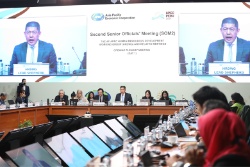Report Documents How Elephant Poaching Supports LRA
Report Documents How Elephant Poaching Supports Lord’s Resistance Army
WASHINGTON – Human rights groups released a multimedia report and video documenting new evidence that the Lord’s Resistance Army, or LRA, has turned to elephant poaching as a means to fuel its atrocities.
“Kony’s Ivory,” co-authored by the Enough Project and the Satellite Sentinel Project, or SSP, and co-produced by Invisible Children and The Resolve, combines photos and satellite imagery of an abandoned LRA camp in Congo’s Garamba National Park with eyewitness reports that LRA fighters rendezvous with helicopters to trade ivory for arms, ammunition, and food.
Co-author Kasper Agger, an Enough Project LRA field researcher based in Kampala, Uganda, stated:
“After months of uncertainty, we now have proof that the LRA is killing elephants trading ivory for resources that help the group to survive. Greater investments are needed to combat the LRA across central Africa. Governments in Asia and elsewhere who fail to regulate the illegal ivory trade share responsibility for atrocities committed by the LRA and other armed groups engaged in poaching.”
International NGO African Parks employs approximately 130 rangers who are charged with patrolling Garamba. But they are outmanned and sometimes outgunned.
Peter Fearnhead, Chief Executive Officer of African Parks, which has jurisdiction and which manages the park on behalf of the Congolese wildlife authority called the Institut Congolais pour la Conservation de la Nature, stated:
“The Lord’s Resistance Army is now part of a larger poaching crisis that is decimating elephants throughout central Africa. The high price of ivory is increasingly incentivizing the involvement of armed groups such as the LRA, sustaining their atrocities in the region. Given the presence of the LRA in Garamba, the Park’s elephants are particularly under threat. In the 1970s, 20,000 elephants roamed Garamba. Today, our management is fighting to conserve the remaining 1,800 to 2,500 elephants. But the battle is far from lost. With more training, better equipment, and intelligence support, Garamba’s elephants will be saved.”
The report offers recommendations to combat the ivory trade. These include the expansion of programs to increase LRA defections, improvement of intelligence gathering and additional support for park rangers and other forces pursuing the LRA, and investment in livelihoods and infrastructure for local communities to provide alternatives to rebel activity and large-scale wildlife poaching. The report also calls for innovative uses of aerial reconnaissance, satellite surveillance, infrared sensors, and radar to track poachers by examining their hiding places, campsites, and water sources.
Report co-author Jonathan Hutson, Director of Communications for the Enough Project and the Satellite Sentinel Project, stated:
“African wildlife parks have become automated teller machines for armed groups that commit atrocities. They find a readily available source of support in poaching elephants and other protected species. That is a driver which contributes to record levels of poaching. Of course, the LRA is not the only group benefiting from the surging black market for ivory. Park rangers suspect that members of the Congolese, Sudanese, South Sudanese, and Ugandan armed forces, as well as janjaweed militias from Darfur, are killing elephants at an accelerating pace.”
Since 2005, Garamba has been one of the LRA’s hiding places in central Africa. But the LRA’s elephant poaching was not previously documented.
Multiple sources report that a group of heavily armed LRA fighters have picked up tusks from rendezvous points in Garamba and transported them north through the Central African Republic towards Sudan. An LRA defector reported that his group, based in the Kafia Kingi enclave – a disputed border region between Sudan and South Sudan – sold tusks poached in Congo to members of the Sudan Armed Forces.
The report concludes that the resources gained from the illegal trade of ivory undercut the efforts of the African Union Regional Task Force soldiers to combat the LRA and undermine the mission of U.S. military advisors to assist their work.
Read the report, “Kony’s Ivory: How Elephant
Poaching in Congo Helps Support the Lord’s Resistance
Army”:
http://www.enoughproject.org/files/KonysIvory.pdf
View the video, “Kony’s Ivory: LRA Poaching in Garamba Park”: http://youtu.be/vODC-EY-IpU
ENDS


 Save The Children: It’s Not Safe And It’s Not Clean, But People Believe They Are Leaving Something Worse Behind
Save The Children: It’s Not Safe And It’s Not Clean, But People Believe They Are Leaving Something Worse Behind APEC: APEC Commits To Empowering People With Disabilities
APEC: APEC Commits To Empowering People With Disabilities UN News: Israeli Forces Bringing War To The West Bank, Warns UN Rights Office
UN News: Israeli Forces Bringing War To The West Bank, Warns UN Rights Office UN News: 10,000 People Feared Buried Under The Rubble In Gaza
UN News: 10,000 People Feared Buried Under The Rubble In Gaza Save The Children: Heat-stricken Bangladesh Extends School Closures
Save The Children: Heat-stricken Bangladesh Extends School Closures Hayden Stephens and Associates: Record Class Action Settlement Gives Hope To 50,000 Australian Junior Doctors
Hayden Stephens and Associates: Record Class Action Settlement Gives Hope To 50,000 Australian Junior Doctors